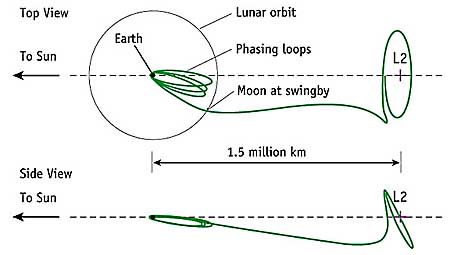
WMAP Trajectory and Orbit
To minimize environmental disturbances and maximize observing efficiency, WMAP observes from a Lissajous orbit about the L2 Sun-Earth Lagrange point 1.5 million km from Earth. The trajectory to reach the observing station consisted of 3 lunar phasing loops followed by a ~100 day cruise to L2.
The Need to go to L2
The Lagrange points mark positions where the combined gravitational pull of two large masses precisely equals the centripetal force required to rotate with them. The L2 Lagrange point offers a virtually ideal location from which to carry out CMB observations. Because of its distance, 1.5 million km from Earth, it affords great protection from the Earth's microwave emission, magnetic fields, and other disturbances. It also provides for a very stable thermal environment and near 100% observing efficiency since the Sun, Earth, and Moon are always behind the instrument's field of view.
WMAP Trajectory to L2
The following sketch indicates the path to L2. The trajectory features 3 or 5 lunar phasing loops depending on when in the lunar cycle WMAP launches (WMAP used only 3) and a lunar flyby to assist the spacecraft in reaching L2. The cruise time to L2 is approximately 100 days after the lunar phasing loops are completed. The launch window for this trajectory is ~20 minutes/day for 7 consecutive days twice each month. Once in orbit about L2, the satellite maintains a Lissajous orbit such that the WMAP-Earth vector remains between 1 and 10 degrees off the Sun-Earth vector to satisfy communications requirements while avoiding eclipses. Station-keeping maneuvers are required about 4 times per year to maintain the orbit.

